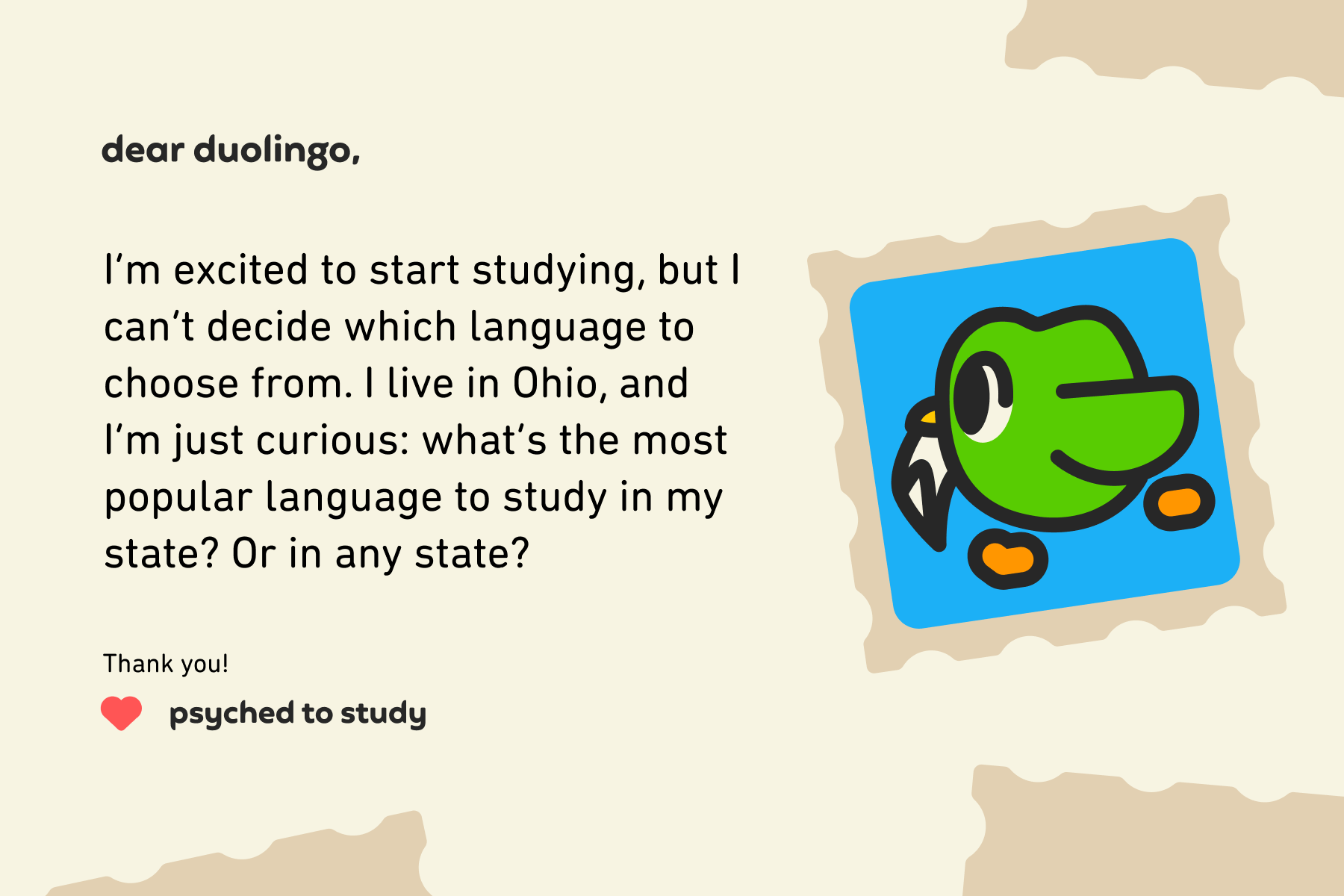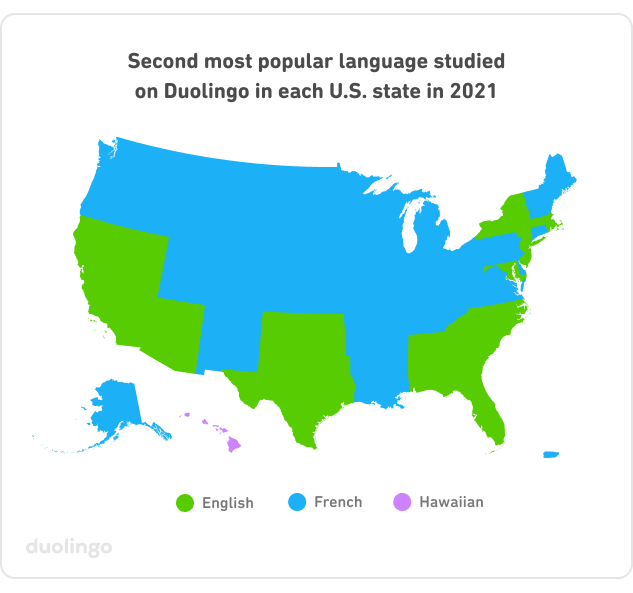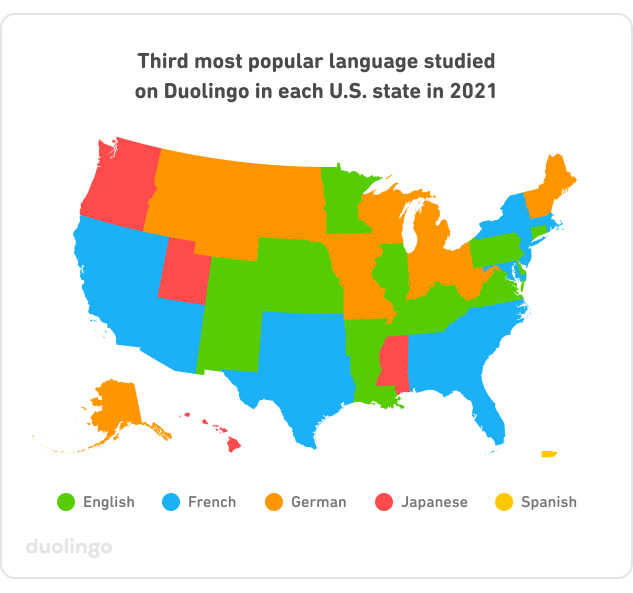Welcome back to Dear Duolingo, a biweekly advice column for language learners! If you missed our first installment, read it here. Now, onto more learning wisdom from our in-house expert, Dr. Cindy Blanco!
What's on your mind today?

Ok, Psyched to Study, I love a good map, so this week on Dear Duolingo we'll talk about the most popular languages across the U.S., and we'll save the other part of your question, about which language to study, for another week. (A lot of you had similar questions! Stay tuned for answers!)
To start, you might be interested in checking out some other U.S. state maps we've put together over the years; you can see what each state was studying back in 2017 and more recently in 2020.
One of my favorite parts of these comparisons is seeing how interests and trends change over time. Some of the new languages on the map (literally) reflect new courses offered on Duolingo, so not really the novelty of interest in the language, but more like confirmation that this is what people wanted to be studying all along. Hawaiian is a good example – you can see how it pops up on the 2020 map, and maybe you already know from a report we conducted last year that its popularity remains strong.
But of course, these maps also show us true changes in peoples' interests, too, which may reflect music, media, pop culture, family, culture, and more. So, what do today's U.S. language maps tell us?
The United States of Spanish learners
We may be divided by politics, regional fast-food chains, and what we call sweetened carbonated beverages (soda? pop?? soda pop?! Coke???), but all 50 U.S. states and Washington, D.C. have this in common: Spanish is the most popular language to study. The dominance of Spanish learners was evident in our data in 2017 and 2020 as well, and Spanish being #1 looks unlikely to change in the near future anywhere in the nation.
The one exception to this comes not from a U.S. state, but from the territory of Puerto Rico, where English is the most commonly studied language. Spanish and English are co-official languages in Puerto Rico, but Spanish is spoken at home by 95% of the population and is the main language used on the island. So naturally English is more popular to study there than Spanish!
More states than ever before are studying English
French is the second choice, behind Spanish, for learners in most states. There are 35 states where French is #2! But there's an even more interesting story in the data.
This year, there are 16 states or territories where English is the second most popular language to study. That's huge! It really speaks to how interested people in the U.S. are to learn English. Duolingo offers 22 different English courses, for speakers of different first languages, so there are learners from dozens of communities and language backgrounds contributing to the popularity of English.

Fun fact: in 2017, there were 11 states where English ranked as #2, and this number dropped in 2020 to 7 states and Washington, D.C. So what happened there? Why would English have gotten less popular for a while? I think this is less about reduction of English popularity and more about growth of interest in other languages—namely, French. What we saw in our 2020 analysis probably reflected how the COVID-19 pandemic changed language-learning trends, and with an increase of over 30 million new learners in the weeks after the first March stay-at-home-order, many new learners were focused on studying the languages that they had been learning in their high school and college classrooms, like Spanish and French. That artificially bumped English down a bit.
Today, the 2021 data shows a sort-of rebound: things are getting back to normal, and more learners in more states are studying English again! This includes people living in the U.S. who are improving their English, but probably also includes students, workers, and tourists who are able to come to the U.S. again.
What our language choices reveal about our history... and our future
Things get even more interesting when you look at the third most popular language to study. Now there are five languages on the map, and the story here is as much about the U.S.'s past immigration as it is about our current interests and family stories.

Each locale falls into one of five categories:
1. English before French
There are 16 states where English is #2 and French is #3, and they are mostly in the southeast, along the southern border with Mexico, or in the west. Many of these areas have strong connections to Mexico—by which I mean, they were Mexico until the mid 19th century – or have growing populations of Spanish speakers who are interested in learning English. I grew up in North Carolina, which is one of these English-before-French states, and there, in 1990, the Hispanic population was around 1%, and today it's over 10%!
2. French before English
There are 14 states where the pattern is reversed, where there are more French learners than there are English learners. Many are in the Mid-Atlantic and Midwest—places that might have smaller new communities of people who don't speak English, or places with communities that have already learned English. There are also some potential surprises in this group, too, like New Mexico and Colorado. What could make those places unlike their neighbors? Could be similar reasons: either less new immigration or immigration of people who already know English. What do you think?
3. German ahead of English
A third group of states are those where French is the second most popular and German is the third most popular language. These states are mostly in New England, the Midwest, and the North, and my guess is that learners here are especially interested in German for reasons of family and heritage. In fact, last year, family became the most common motivation for new U.S. learners who started studying a language on Duolingo!
4. Trailblazers: getting Japanese on the map
Since 2020, there has been a handful of states where Japanese ranks #3—but it's a different group of states each year! In 2021, Mississippi, Oregon, Utah, and Washington all studied French as #2 and Japanese as #3—and Mississippi was on this exclusive list in 2020 as well. Interest in Japanese is bubbling up around the country (and around the world), and it'll be fun to check back in a few years and see which states have coalesced around studying Japanese.
5. Hawai'i!
Hawai'i is in a class all its own: Hawaiian is the second most popular language to study in Hawai'i, and Japanese comes in at #3. People studying in Hawaii demonstrate an interest in Asian languages, especially those reflecting the heritage of its population. This was evident even in 2017, and learners in Hawaii have continued to study personally meaningful languages like Hawaiian and Japanese.
Putting learning on the map
Thanks, Psyched to Study, for your question! I love what data can show us about larger learning trends, and I hope you are able to see yourself in the numbers, too – whether your language interests relate to family, culture, or the new members of your own community!
We'll be back in two weeks with the next installment of Dear Duolingo, where we'll be answering more questions about language learning! You can submit your questions at dearduolingo@duolingo.com or by tagging us on social media with #DearDuolingo.



